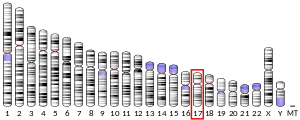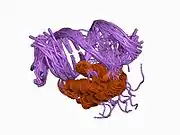HOXB6
Homeobox protein Hox-B6 is a protein that in humans is encoded by the HOXB6 gene.[5][6][7]
Function
This gene is a member of the Antp homeobox family and encodes a protein with a homeobox DNA-binding domain. It is included in a cluster of homeobox B genes located on chromosome 17. The encoded protein functions as a sequence-specific transcription factor that is involved in development, including that of lung and skin, and has been localized to both the nucleus and cytoplasm. Altered expression of this gene or a change in the subcellular localization of its protein is associated with some cases of acute myeloid leukemia and colorectal cancer.[7]
During development
HOX B6 gene is only expressed in erythoid progenitor cells, which are the precursor to red blood cells used for transport of oxygen and carbon dioxide throughout the body. During development, the formation of the HOX gene factor happens in the first stages of fetal development, namely soon after the establishment of the mesoderm, which is the “middle layer” of the future embryo. However, HOX B6 is only expressed once the undifferentiated stem cells of the embryo distinguish themselves into the erythpoietic phase. The research has shown that HOX B6 is not expressed in hematopoietic stem cells located in the red bone marrow, which are the precursor cells to all types of blood cells, or primordial germ cells (PGCs), the precursor to cells passed on in each generation.[8] Since it is a transcriptional factor, HOX B6 regulates erythpoigenesis (red blood cell formation) using mRNA as the basis for certain protein productions. The specific gene factor for erytopoigenesis has relatively been unobserved in the scientific community, and no known diseases have been associated with a defect HOX B6 gene. However, it has been shown in correlation with major skeletal deformations.[9]
HOXB6 is a structural protein that has been shown to influence the growth and differentiation of the different blood lineages. This gene has also been shown to encourage the growth of granulocytes and monocytes, but at the cost of other blood cells. HOXB6 has the ability to cause the indefinite proliferation of murine marrow cells, as well as expand hematopoietic stem cells. When expressed abnormally, HOXB6 displays many characteristics of a potent oncoprotein. An oncoprotein can cause the transformation of a normal cell into a tumor cell. Overexpression of HOXB6, along with the addition of MEIS1 protein, has been implicated in the development of acute myeloid leukemia (AML). Acute myeloid leukemia is a cancer of the blood cells, specifically the leukocytes. The chromosomal irregularity most frequently seen in HOXB6 AML is a reappearing interstitial deletion of chromosome 2. Fundamental HOXB6 expression stops myeloid differentiation and debilitates erythropoiesis, megakaryopoiesis, and lymphopoiesis.[10]
See also
References
- GRCh38: Ensembl release 89: ENSG00000108511 - Ensembl, May 2017
- GRCm38: Ensembl release 89: ENSMUSG00000000690 - Ensembl, May 2017
- "Human PubMed Reference:". National Center for Biotechnology Information, U.S. National Library of Medicine.
- "Mouse PubMed Reference:". National Center for Biotechnology Information, U.S. National Library of Medicine.
- McAlpine PJ, Shows TB (Jul 1990). "Nomenclature for human homeobox genes". Genomics. 7 (3): 460. doi:10.1016/0888-7543(90)90186-X. PMID 1973146.
- Scott MP (Nov 1992). "Vertebrate homeobox gene nomenclature". Cell. 71 (4): 551–3. doi:10.1016/0092-8674(92)90588-4. PMID 1358459. S2CID 13370372.
- "Entrez Gene: HOXB6 homeobox B6".
- Zimmermann F, Rich IN (Apr 1997). "Mammalian homeobox B6 expression can be correlated with erythropoietin production sites and erythropoiesis during development, but not with hematopoietic or nonhematopoietic stem cell populations". Blood. 89 (8): 2723–35. doi:10.1182/blood.V89.8.2723. PMID 9108390.
- Rancourt DE, Tsuzuki T, Capecchi MR (Jan 1995). "Genetic interaction between hoxb-5 and hoxb-6 is revealed by nonallelic noncomplementation". Genes & Development. 9 (1): 108–22. doi:10.1101/gad.9.1.108. PMID 7828847.
- Fischbach NA, Rozenfeld S, Shen W, Fong S, Chrobak D, Ginzinger D, Kogan SC, Radhakrishnan A, Le Beau MM, Largman C, Lawrence HJ (2005). "HOXB6 overexpression in murine bone marrow immortalizes a myelomonocytic precursor in vitro and causes hematopoietic stem cell expansion and acute myeloid leukemia in vivo". Blood. 105 (4): 1456–66. doi:10.1182/blood-2004-04-1583. PMID 15522959.
Further reading
- Kaur S, Singh G, Stock JL, Schreiner CM, Kier AB, Yager KL, Mucenski ML, Scott WJ, Potter SS (Dec 1992). "Dominant mutation of the murine Hox-2.2 gene results in developmental abnormalities". The Journal of Experimental Zoology. 264 (3): 323–36. doi:10.1002/jez.1402640311. PMID 1358998.
- Shen WF, Detmer K, Simonitch-Eason TA, Lawrence HJ, Largman C (Feb 1991). "Alternative splicing of the HOX 2.2 homeobox gene in human hematopoietic cells and murine embryonic and adult tissues". Nucleic Acids Research. 19 (3): 539–45. doi:10.1093/nar/19.3.539. PMC 333645. PMID 1672751.
- Peverali FA, D'Esposito M, Acampora D, Bunone G, Negri M, Faiella A, Stornaiuolo A, Pannese M, Migliaccio E, Simeone A (Oct 1990). "Expression of HOX homeogenes in human neuroblastoma cell culture lines". Differentiation; Research in Biological Diversity. 45 (1): 61–9. doi:10.1111/j.1432-0436.1990.tb00458.x. PMID 1981366.
- Giampaolo A, Acampora D, Zappavigna V, Pannese M, D'Esposito M, Carè A, Faiella A, Stornaiuolo A, Russo G, Simeone A (Jun 1989). "Differential expression of human HOX-2 genes along the anterior-posterior axis in embryonic central nervous system". Differentiation; Research in Biological Diversity. 40 (3): 191–7. doi:10.1111/j.1432-0436.1989.tb00598.x. PMID 2570724.
- Shen WF, Largman C, Lowney P, Corral JC, Detmer K, Hauser CA, Simonitch TA, Hack FM, Lawrence HJ (Nov 1989). "Lineage-restricted expression of homeobox-containing genes in human hematopoietic cell lines". Proceedings of the National Academy of Sciences of the United States of America. 86 (21): 8536–40. Bibcode:1989PNAS...86.8536S. doi:10.1073/pnas.86.21.8536. PMC 298317. PMID 2573064.
- Acampora D, D'Esposito M, Faiella A, Pannese M, Migliaccio E, Morelli F, Stornaiuolo A, Nigro V, Simeone A, Boncinelli E (Dec 1989). "The human HOX gene family". Nucleic Acids Research. 17 (24): 10385–402. doi:10.1093/nar/17.24.10385. PMC 335308. PMID 2574852.
- Boncinelli E, Acampora D, Pannese M, D'Esposito M, Somma R, Gaudino G, Stornaiuolo A, Cafiero M, Faiella A, Simeone A (1990). "Organization of human class I homeobox genes". Genome. 31 (2): 745–56. doi:10.1139/g89-133. PMID 2576652.
- Murphy PD, Ferguson-Smith AC, Miki T, Feinberg AA, Ruddle FH, Kidd KK (Aug 1987). "A moderately frequent RFLP identified by both SacI and BanII with a probe from the HOX2 locus in man (17q11-17q22)". Nucleic Acids Research. 15 (15): 6311. doi:10.1093/nar/15.15.6311. PMC 306101. PMID 2888083.
- Levine M, Rubin GM, Tjian R (Oct 1984). "Human DNA sequences homologous to a protein coding region conserved between homeotic genes of Drosophila". Cell. 38 (3): 667–73. doi:10.1016/0092-8674(84)90261-7. PMID 6091895. S2CID 28848659.
- Chang CP, Shen WF, Rozenfeld S, Lawrence HJ, Largman C, Cleary ML (Mar 1995). "Pbx proteins display hexapeptide-dependent cooperative DNA binding with a subset of Hox proteins". Genes & Development. 9 (6): 663–74. doi:10.1101/gad.9.6.663. PMID 7729685.
- Castronovo V, Kusaka M, Chariot A, Gielen J, Sobel M (Jan 1994). "Homeobox genes: potential candidates for the transcriptional control of the transformed and invasive phenotype". Biochemical Pharmacology. 47 (1): 137–43. doi:10.1016/0006-2952(94)90447-2. PMID 7906121.
- Apiou F, Flagiello D, Cillo C, Malfoy B, Poupon MF, Dutrillaux B (1996). "Fine mapping of human HOX gene clusters". Cytogenetics and Cell Genetics. 73 (1–2): 114–5. doi:10.1159/000134320. PMID 8646877.
- Sawcer S, Jones HB, Feakes R, Gray J, Smaldon N, Chataway J, Robertson N, Clayton D, Goodfellow PN, Compston A (Aug 1996). "A genome screen in multiple sclerosis reveals susceptibility loci on chromosome 6p21 and 17q22". Nature Genetics. 13 (4): 464–8. doi:10.1038/ng0896-464. PMID 8696343. S2CID 20543659.
- Zimmermann F, Rich IN (Apr 1997). "Mammalian homeobox B6 expression can be correlated with erythropoietin production sites and erythropoiesis during development, but not with hematopoietic or nonhematopoietic stem cell populations". Blood. 89 (8): 2723–35. doi:10.1182/blood.V89.8.2723. PMID 9108390.
- Vider BZ, Zimber A, Hirsch D, Estlein D, Chastre E, Prevot S, Gespach C, Yaniv A, Gazit A (Mar 1997). "Human colorectal carcinogenesis is associated with deregulation of homeobox gene expression". Biochemical and Biophysical Research Communications. 232 (3): 742–8. doi:10.1006/bbrc.1997.6364. PMID 9126347.
- Ohnishi K, Tobita T, Sinjo K, Takeshita A, Ohno R (Nov 1998). "Modulation of homeobox B6 and B9 genes expression in human leukemia cell lines during myelomonocytic differentiation". Leukemia & Lymphoma. 31 (5–6): 599–608. doi:10.3109/10428199809057620. PMID 9922051.
- Fienberg AA, Nordstedt C, Belting HG, Czernik AJ, Nairn AC, Gandy S, Greengard P, Ruddle FH (Apr 1999). "Phylogenetically conserved CK-II phosphorylation site of the murine homeodomain protein Hoxb-6". The Journal of Experimental Zoology. 285 (1): 76–84. doi:10.1002/(SICI)1097-010X(19990415)285:1<76::AID-JEZ9>3.0.CO;2-K. PMID 10327653.
- Vider BZ, Zimber A, Chastre E, Gespach C, Halperin M, Mashiah P, Yaniv A, Gazit A (Jun 2000). "Deregulated expression of homeobox-containing genes, HOXB6, B8, C8, C9, and Cdx-1, in human colon cancer cell lines". Biochemical and Biophysical Research Communications. 272 (2): 513–8. doi:10.1006/bbrc.2000.2804. PMID 10833444.
External links
- HOXB6+protein,+human at the US National Library of Medicine Medical Subject Headings (MeSH)
- Overview of all the structural information available in the PDB for UniProt: Q24645 (Drosophila subobscura Homeotic protein antennapedia) at the PDBe-KB.
This article incorporates text from the United States National Library of Medicine, which is in the public domain.











